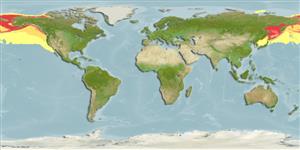Phoca largha Pallas, 1811
Larga seal| Native range | All suitable habitat | Point map | Year 2050 |

|
| This map was computer-generated and has not yet been reviewed. |
| Phoca largha AquaMaps Data sources: GBIF OBIS |
Classification / Names Common names | Synonyms | CoL | ITIS | WoRMS
Mammalia | Carnivora | Phocidae
Environment: milieu / climate zone / depth range / distribution range Ecology
Bathydemersal. Subtropical; 90°N - 0°S, 126°E - 115°W
Distribution Countries | FAO areas | Ecosystems | Occurrences | Introductions
Pacific Ocean and the Arctic: Eastern side of Ostrov Sakhalin to northern Hokkaido. Subtropical to polar.
Length at first maturity / Size / Weight / Age
Maturity: Lm ? range ? - ? cm Max length : 170 cm TL male/unsexed; (Ref. 1394); 160 cm TL (female); max. published weight: 123.0 kg (Ref. 1394)
Inhabit the southern edges of the pack ice from winter to early summer and coastal areas including river mouths, in late summer and autumn. Diet composition varies with the age of the seal; Newly weaned pups feed on small crustaceans, advance to schooling fishes, larger crustaceans, and octopuses, and finally graduate to bottom dwelling fish and cephalopods (Ref. 1394).
Life cycle and mating behavior Maturity | Reproduction | Spawning | Eggs | Fecundity | Larvae
Main reference
References | Coordinator | Collaborators
Jefferson, T.A., S. Leatherwood and M.A. Webber. 1993. (Ref. 1394)
IUCN Red List Status (Ref. 130435: Version 2024-1)
Least Concern (LC) ; Date assessed: 03 June 2015
CITES status (Ref. 108899)
Not Evaluated
CMS (Ref. 116361)
Not Evaluated
Threat to humans
Human uses
Fisheries: commercial
FAO - Fisheries: landings, species profile | FishSource | Sea Around Us
Tools
More information
Trophic Ecology
Ecology
Population dynamics
Life cycle
Reproduction
Maturity
Fecundity
Spawning
Eggs
Egg development
Larvae
Larval dynamics
Maturity
Fecundity
Spawning
Eggs
Egg development
Larvae
Larval dynamics
Distribution
Human Related
Aquaculture profile
Stamps, Coins Misc.
Stamps, Coins Misc.
Outreach
Taxonomy
References
Internet sources
BHL | BOLD Systems | CISTI | DiscoverLife | FAO(Fisheries: species profile; publication : search) | Fishipedia | GenBank (genome, nucleotide) | GloBI | Gomexsi | Google Books | Google Scholar | Google | PubMed | Tree of Life | Wikipedia (Go, Search) | Zoological Record
Estimates based on models
Preferred temperature
(Ref. 115969): -0.6 - 5.6, mean 2.2 (based on 1984 cells).
Resilience
(Ref. 69278):
Medium, minimum population doubling time 1.4 - 4.4 years (K=0.16-0.44).
Price category
(Ref. 80766):
Unknown.



